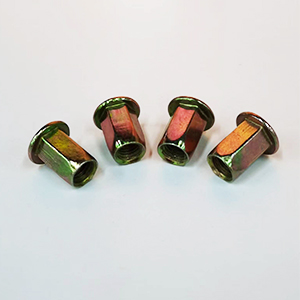What are the advantages of rivet nuts?
Our rivet nuts: high salt spray resistance, strong corrosion resistance, not easy to rust. The appearance of the product is bright and delicate, the edges and corners are clear, the end surface is smooth, and the dimensional accuracy is high. The riveting effect is good, the riveting is not warped, the gun head is not stuck. Riveting After turning the torsion foot, the tension is good. The product is full of stripes: no burr, shiny. After passing the check of the pass and stop gauge, the stretching effect is good, and the locking screw is not deformed. The product has no impurities and the material composition is stable; the material is Baosteel, imported new Japan Railway.
What is the installation method of the rivet nut?
The riveting nut is riveted with a riveting gun. Then it is suitable for operation in places that are not easy to riveted such as square tubes. The riveting nut also makes up for some shortcomings of electric welding, such as beauty, and places that are not easy to weld, such as thin plates.
Precautions for using rivet nuts
1. Check whether the nozzle screw is assembled with the correct rivet nut size, select the corresponding nozzle and rivet bolt, and whether the connecting parts are firm.
2. Pay attention to the deformation length or displacement of the rivet nut, and then correctly adjust the opening angle of the operating rod.
3. The scale ring of the rivet nut gun is used to adjust the rivet stroke, which can be adjusted as needed during operation. It is worth noting that when adjusting the length of the rivet bolt, it is necessary to open two handles and adjust the gun head sleeve to expose the rivet bolt. The length of the rivet nut is slightly larger than the exposed length of the rivet nut, and then tighten the adjustment nut and the gun body.
4. Then, pull out all the bakelite with open hands, put the corresponding rivet nut on the 2 ends of the rivet bolt and clamp it, push the bakelite to screw the gun head bolt, and then insert the rivet nut into the pre-drilled hole of the rivet piece Then press the hands together. At this time, the rivet nut expands to riveted the workpiece, and then pull out the bakelite ball, and the rivet nut will withdraw from the threaded hole. That is to say, the rivet nut machine can be completed.

Related Industry Knowledge
- Types and uses of rivets
- Use of rivet gun
- Application and characteristics of lantern rivets
- Dealing with surface problems and common phenomena of blind rivets
- Introduction of seahorse rivets
- The difference between ring groove rivets and groove rivets
- The use and precautions of ring groove rivets
- Development and working principle of blind rivets
- Uses and advantages of large brim blind rivets
- Characteristics of brushed rivets
- How to choose blind rivets, and what aspects must be paid attention to?
- The whole process of using and installing ring groove rivets
- What are the solutions when the riveting gun fails?
- Common problems when installing ring groove rivets



